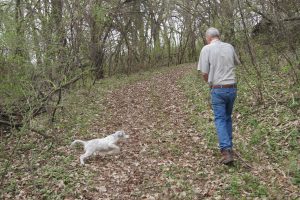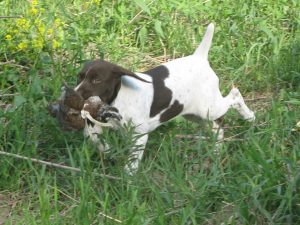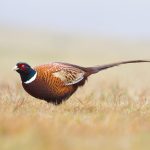Training the Dog that Lacks Motivation
POINTING DOG POINTERS September 2018
By Bob and Jody Iler
We’ve been looking at ways to successfully develop both “soft” and “hard” pointing dog pups. But what about the pup that doesn’t show much interest in birds or hunting? The one that lacks motivation or drive? The one that doesn’t seem to have, as we say, the “eye of the tiger?”
This pup may be happy to mosey along in the field close to you, smelling the wildflowers. It’s possible that this pup may show a little apprehension about being in the field. He or she may even completely avoid or ignore any birds planted in the area. And then there’s the pup that, when finding a bird, sniffs it with disinterest and continues on its way. Finally, we once had a dog in our kennel for training that, upon finding a planted bird, promptly lifted his leg on it – leaving no doubt about his enthusiasm for birds.
If your heart is sinking as you read this, don’t despair!
First, let’s take a look at some of the factors that might contribute to your pup’s lack of drive.
Genetics
As always, the pedigree of your pup plays a big role in pup’s potential as a bird dog. Pups that come from proven lines of field trial/hunt test achievers should generally have what it takes to make excellent hunting dogs. The old saying, “Pick the litter, not the pup,” often rings true. That’s not to say that you won’t find a good pointing dog pup from hunting bloodlines. If you can see dad or mom, or both, in action in the field, all the better! Starting with a good pedigree helps ensure that your pointing dog pup will have what it takes.
Training Methods
Here is where the eager, novice pointing dog owner can get into trouble. Putting too much pressure on the young pup and pushing him too hard can often shut down a promising young student. Overuse of the electronic collar, trying to force-break a young pup, or trying to steady one to wing and shot, can often result in lack of drive and motivation. In the initial development of your puppy, all you want to do is get him or her excited about birds and eager to get out and hunt for them. Put the e-collar and the advanced training exercises on the back burner for much later.
Improper Bird Introduction
Acquainting pups with birds is an area that can trip up the eager, but novice trainer. Birds should be introduced gradually, using smaller, hobbled quail at first to gauge pup’s reaction and develop his understanding and enthusiasm of what he was born to do! Hunting pup too soon on larger birds can leave her frightened and unsure of whether this is fun or not.
Improper Gun Introduction
Adding noise to the mix before the young pup is ready can be a recipe for disaster. Not only will your pup lack drive, you may set him back indefinitely in your training program and create a problem that can be tough to resolve. Noise shouldn’t be introduced until your pup is chasing birds with enthusiasm and having the time of his life. And then, gunfire should be introduced in progressive levels, always watching for pup’s reaction and adjusting accordingly.
Using Pigeons instead of Gamebirds
Pigeons are great for training most pups, but the occasional pup comes along that really wants nothing to do with them. You don’t want to make the mistake of writing off a pup that won’t work a pigeon! Often the answer to firing up this pup’s enthusiasm is to get her out on quail and other gamebirds as time progresses.
Now, what are some possible remedies for the situation?
Make EVERYTHING Fun
In the beginning, God created your little pointing dog pup to have fun! It’s your job to make sure that that happens by bringing pup along at his own pace, slowly introducing birds – and later, noise – and always reading pup for his reactions as you develop him.
Birds and Chasing
Use plenty of birds (properly introduced and starting with smaller gamebirds) to allow the pup to learn scenting recognition and skills, develop his hunting abilities, and find and chase the birds. At this stage, don’t worry about your pointing dog pup’s point! That will come. What’s more important now is that every time she goes to the field, pup is excited, full of enthusiasm and eager and ready to go. If you can accomplish that, the rest will come.
Jealousy Method
If you have a hunting buddy with a trained dog, have your buddy work his dog on birds while you let your pup watch from a short distance away, restraining your pup gently with a lead. Refrain from using a gun and let the birds fly after the flush. If your pup gets excited as he watches the scenario, praise and encourage him. If he seems enthusiastic enough to join in, pick up the other dog and turn your pup loose. Be sure to have some quail left for him to find and chase.
Take your Time
Allow time for the magic to kick in! Your pup is as different from the next one as kids in school are. Don’t compare him to your buddy’s dog and what that dog did at the age your pup is at now. Your pup is his own unique individual self, with his own timetable. All good things come in time. Evaluate as you go, back up when necessary, and focus on fun and birds before you worry about any advanced training. Developing the “eye of the tiger” can take time, but it’s worth it in the long run.
Finally, here are two examples of pointing dog pups that lacked enthusiasm in the early days of their training. We won’t mention the breeds, because lack of motivation is not specific to any one breed!
Kai was a quality pup that came to our kennel at the age of about five months. He was sound and well socialized. Kai was one of our “wildflower sniffers” who happily enjoyed a romp in the fields or woods. His introduction to birds was less than sensational. Though he regarded them as part of the landscape, Kai took no particular interest in any bird – be it pigeon or quail – whether it was running or flying. The birds just didn’t faze him – he’d amble about, find a bird, and keep on going – not caring one bit about the bird or where it went. Though we tried everything in our bag of training tools to interest Kai in birds, it just didn’t happen. He went home to a career as a loved house pet. His owner got another pointing dog of the same breed that later came to our kennel and turned on to birds with fire and drive.
Buddy was a young, well-bred pup with very little socialization or experience in anything when he came to us. All things new were cause for alarm for him. Buddy initially ran out the field back to the security of his kennel when first introduced to the field and birds. With this guy, everything was new and scary to him. In time, with gentle exposure to just plain fun in the field and the wonderful little quail that often awake the sleeping bird dog giant, Buddy came around. And when he did, it was breathtaking. He would stay immobile on point for ages, only his eyes moving, as we walked in front of him to flush the bird. Had we given up too soon on him, this might not have happened. Buddy went on to live a long and happy life in Wisconsin as a top notch pointing dog and treasured member of the family.
Developing enthusiasm and motivation in your pointing dog pup is Job One. Give pup all the time he or she needs to let the spark ignite, evaluating honestly as you go along. Much of the time, you’ll be rewarded with the pointing dog you’ve dreamed of! Good luck!







